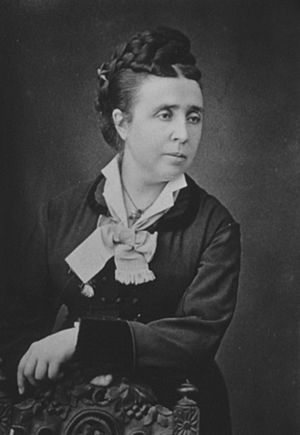Marie-Lydie Cabanis Bonfils facts for kids
Marie-Lydie Bonfils (born Cabanis) was a pioneering photographer. She was the first professional woman photographer in the Middle East. Born in France, she worked in Lebanon and nearby areas. This was during the late 1800s and early 1900s. Lydie and her husband, Félix Bonfils, started "Maison Bonfils". It was the first and most successful photo studio in Beirut.
Contents
Starting a Family and Moving to Beirut
Lydie married Félix Bonfils on August 27, 1857. They had two children: Félicité-Sophie (born 1858) and Paul Félix Adrien, known as Adrien (born 1861).
Félix was a bookbinder. He joined a military trip to the Middle East in 1860. This was during a civil conflict in Lebanon. When he came back, Félix told Lydie exciting stories about Lebanon. She really wanted to see it.
Félix learned a special printing method called heliogravure. By 1864, he was running a printing business.
Their son, Adrien, became very sick with whooping cough. Doctors thought a change in climate would help him. So, Lydie took Adrien to Beirut. The trip helped Adrien get better. In 1867, the whole family moved from France to Beirut.
Building a Photography Business
Once in Beirut, the Bonfils family opened their photo studio. It was called "Maison Bonfils". The studio took many kinds of pictures. They made studio portraits of people. They also created staged scenes that looked like Bible stories. Plus, they took photos of landscapes and wide panoramic views.
Lydie's Role in the Studio
Lydie was very important to the business. She handled many office tasks. Her work grew when the studio opened more branches. They had studios in Cairo and Alexandria. They even worked with an agency in New York.
Lydie also helped prepare the special paper for photos. This paper used a coating made from egg whites, called albumen. Separating the egg whites from the yolks was a long and messy job. Her grandson said that when Lydie left Beirut in 1916, she declared she never wanted to smell another egg again!
Women in Photography
At first, people thought Félix took all the photos. But now we know Lydie and Adrien also took many pictures. They also had several assistants.
It was hard for photographers to find people to photograph in the Middle East. This was partly because of local religious and cultural beliefs. It was especially hard to photograph women. As a woman, Lydie was more accepted as a photographer for Middle Eastern women.
People thought it was too dangerous for Lydie to take photos outside. So, her work was likely mostly studio portraits. However, some evidence suggests she took landscape photos too. An English clergyman mentioned "Madame Bonfils of Beyrout" as a source for pictures of Palestine in his 1874 book.
Running the Studio Alone
Lydie managed the studio when Félix went back to France in 1876. He went to publish his photo collections. In 1878, the studio's name changed to "F. Bonfils et Cie". Adrien, who had finished his studies, took on more photography work then.
Félix traveled to France again in 1880. He started a new printing factory there. He died in France in 1885.
Adrien stayed at the studio until the early 1900s. Then, he left to open a hotel. Lydie continued to run the studio. She had help from another photographer, Abraham Guiragossian. In 1907, Lydie published a book of photos from the studio. It was called Catalogue général des vues photographiques de l’Orient.
Lydie's career ended when the Ottoman Empire entered World War I. She and her family were moved to Cairo. She died there in 1918 and was buried. After Lydie's death, Guiragossian bought the studio and all the Bonfils' old photos. He kept Lydie's name connected to the studio. He signed his photos, "Lydie Bonfils photographe, Beyrouth (Syrie) successeur A. Guiragossian."
Images for kids
-
Baalbek panorama, 1870








